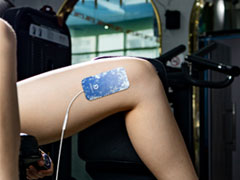
No, TENS and EMS pads are not the same. TENS (Transcutaneous Electrical Nerve Stimulation) and EMS (Electrical Muscle Stimulation) are two different forms of electrical stimulation. Both treatments are used to help reduce pain and are becoming increasingly popular in physical therapy and rehabilitation.

TENS is a form of electrical stimulation that sends low-intensity electrical pulses through electrodes placed on the skin to stimulate the nerves. These electrical pulses can reduce pain by blocking the pain signals from reaching the brain and by stimulating the production of endorphins, the body's natural pain reliever. TENS is usually used to treat chronic pain, such as lower back pain, neck pain, and arthritis.

EMS, on the other hand, is a form of electrical stimulation that sends higher-intensity electrical pulses through electrodes placed on the skin to stimulate muscles. This type of stimulation is often used to strengthen muscles, increase range of motion, improve circulation, and reduce swelling. It can also be used to treat chronic conditions such as fibromyalgia, arthritis, and muscle spasms.
TENS and EMS pads are not interchangeable. TENS pads are specifically designed for the low-intensity electrical stimulation produced by TENS machines, while EMS pads are specifically designed for the higher-intensity electrical stimulation produced by EMS machines. Therefore, it is important to make sure that you are using the correct pads for the correct treatment. Both TENS and EMS treatments can be beneficial for reducing pain and improving physical health. However, it is important for people to consult with their doctor or physical therapist before using either treatment to ensure that it is the right option for their needs.

Case Study: Chronic Neck and Lower Back Pain
Matt is a 65-year-old man who has been suffering from chronic neck and lower back pain for several years. He has tried various methods of pain relief, including over-the-counter medications and physical therapy, but none of them have been able to provide him with lasting relief. After consulting with his doctor, Matt decided to try a combination of TENS and EMS for his pain relief. Matt began using a TENS machine for 30 minutes each day, with the electrodes placed on his lower back and neck. After a week of using the TENS machine, Matt reported feeling less pain and increased range of motion. He then began using an EMS machine for 30 minutes each day, with the electrodes placed on his lower back and neck. After a few weeks of using the EMS machine, Matt reported feeling even less pain and improved range of motion. Matt has been using a combination of TENS and EMS for his pain relief for several months now, and he reports that it has been incredibly effective. His pain has been reduced significantly, and he has been able to increase his physical activity levels. Matt is very pleased with the results of his TENS and EMS treatments and would highly recommend them to anyone suffering from chronic pain.
Besides, the type of electrode used in TENS therapy depends on the area of the body being treated. Different types of electrodes are available in various shapes and sizes, and can be tailored to the individual needs of the patient. Here is a look at the different types of electrodes used in TENS therapy:
1. Sponge Electrodes:
These are the most common type of electrodes used in TENS therapy. They are made from foam or sponge and are designed to be placed on the skin, where they will absorb moisture and allow the electrical current to pass through.
2. Conductive Gel Electrodes:
These electrodes are made from a conductive gel material, which helps to ensure that the electrical current passes through the skin more evenly. They are generally more comfortable to wear than sponge electrodes and can provide better coverage over larger areas of the body.
3. Self-Adhesive Electrodes:
These electrodes are designed to be placed directly on the skin and are held in place by a self-adhesive backing. This makes them easier to apply and more comfortable to wear than sponge or conductive gel electrodes.
4. Dry Electrodes:
These electrodes are designed to be placed directly on the skin without the use of any type of backing or adhesive. They are often used in areas that are difficult to reach with other types of electrodes.
5. Disposable Electrodes:
These electrodes are designed to be used one time and then discarded. They are often used in areas that are difficult to reach with other types of electrodes and are more cost-effective than reusable ones.
No matter which type of electrode you use for your TENS therapy, it is important to make sure that you follow the instructions for use carefully. If you have any questions, talk to your doctor or physical therapist for more information.